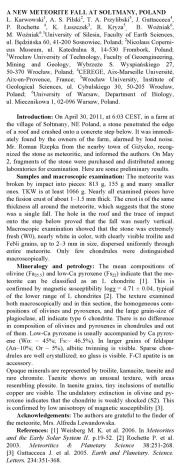(Unless otherwise stated, the copyright of the materials included belong to Jan Woreczko & Wadi.)
Sołtmany/Abstract
Z Wiki.Meteoritica.pl
- A NEW METEORITE FALL AT SOŁTMANY, POLAND
Ł. Karwowski1, A. S. Pilski2, T. A. Przylibski3, J. Gattacceca4, P. Rochette4, K. Łuszczek3, R. Kryza5, B. Woźniak, M. Woźniak6.
1University of Silesia, Faculty of Earth Sciences, ul. Będzińska 60, 41-200 Sosnowiec, Poland; 2Nicolaus Copernicus Museum, ul. Katedralna 8, 14-530 Frombork, Poland; 3Wrocław University of Technology, Faculty of Geoengi-neering, Mining and Geology, Wybrzeże S. Wyspiańskiego 27, 50-370 Wrocław, Poland; 4CEREGE, Aix-Marseille Uni-versité, Aix-en-Provence, France; 5Wrocław University, Institute of Geological Sciences, ul. Cybulskiego 30, 50-205 Wrocław, Poland; 6University of Warsaw, Department of Biology, ul. Miecznikowa 1, 02-096 Warsaw, Poland.
Introduction: On April 30, 2011, at 6:03 CEST, in a farm at the village of Sołtmany, NE Poland, a stone penetrated the edge of a roof and crushed onto a concrete step below. It was immediately found by the owners of the farm, alarmed by loud noise. Mr. Roman Rzepka from the nearby town of Giżycko, recognized the stone as meteoritic, and informed the authors. On May 2, fragments of the stone were purchased and distributed among laboratories for examination. Here are some preliminary results.
Samples and macroscopic examination: The meteorite was broken by impact into pieces: 813 g, 155 g and many smaller ones. TKW is at least 1066 g. Nearly all examined pieces have the fusion crust of about 1-1.5 mm thick. The crust is of the same thickness all around the meteorite, which suggests that the stone was a single fall. The hole in the roof and the trace of impact onto the step below proved that the fall was nearly vertical. Macroscopic examination showed that the stone was extremely fresh (W0), nearly white in color, with clearly visible troilite and FeNi grains, up to 2-3 mm in size, dispersed uniformly through entire meteorite. Only few chondrules were distinguished macroscopically.
Mineralogy and petrology: The mean compositions of olivine (Fa25.5) and low-Ca pyroxene (Fs22) indicate that the me-teorite can be classified as an L chondrite [1]. This is confirmed by magnetic susceptibility logχ = 4.71±0.04, typical of the lower range of L chondrites [2]. The texture examined both macroscopically and in thin section, the homogeneous compositions of olivines and pyroxenes, and the large grain-size of plagioclase, all indicate type 6 chondrite. There is no difference in composition of olivines and pyroxenes in chondrules and out of them. Low-Ca pyroxene is usually accom-panied by Ca pyroxene (Wo: ~45%; Fs:~46.5%). In larger grains of feldspar (An ~10%; Or ~5%), albitic twinning is visi-ble. Sparse chondrules are well crystallized; no glass is visible. F-Cl apatite is an accessory. Opaque minerals are represented by troilite, kamacite, taenite and rare chromite. Taenite shows an unusual texture, with areas resembling plessite. In taenite grains, tiny inclusions of metallic copper are visible. The undulatory extinction in olivine and pyroxene indi-cates that the chondrite is weakly shocked (S2). This is confirmed by low anisotropy of magnetic susceptibility [3].
Acknowledgements: The authors are grateful to the finder of the meteorite, Mrs. Alfreda Lewandowska.
References: [1] Weisberg M. K. et al. 2006. In Meteorites and the Early Solar System II. p.19-52. [2] Rochette P. et al. 2003. Meteoritics & Planetary Science 38:251-268. [3] Gattacceca J. et al. 2005. Earth and Planetary Science. Letters. 234:351-368.
